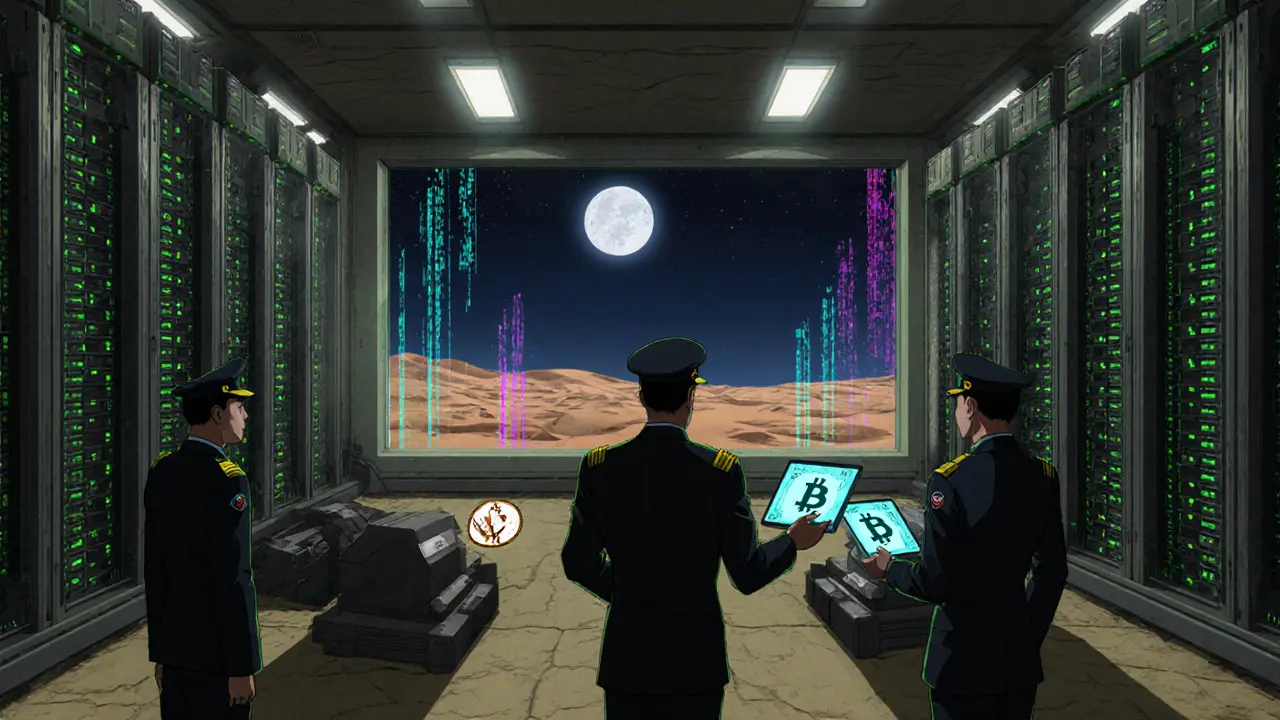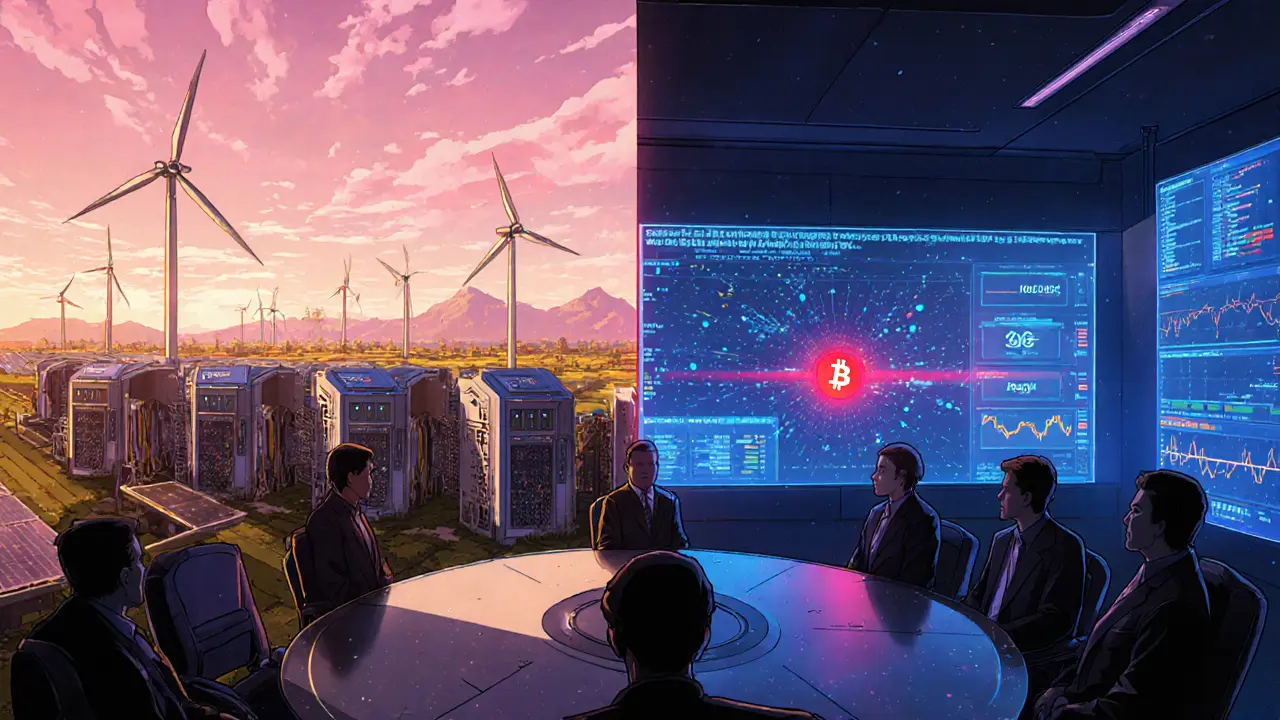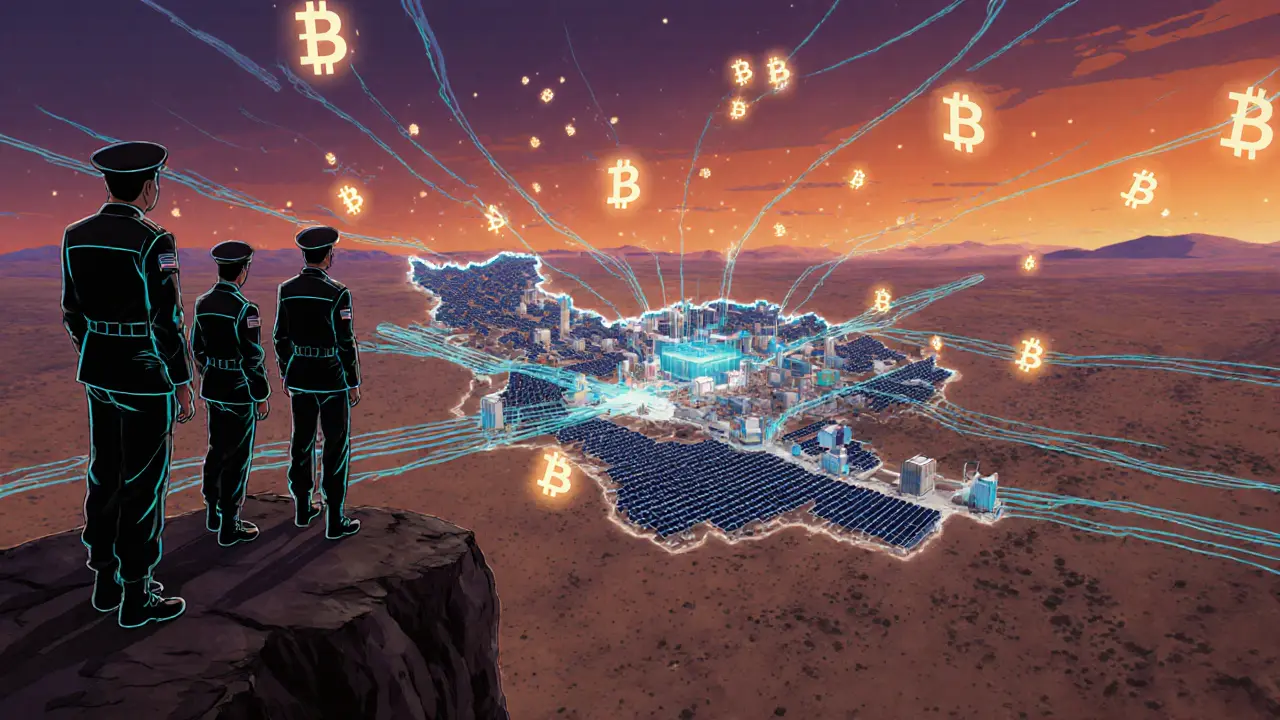Iran Bitcoin Mining Impact Estimator
Estimate Economic Impact of Iran's Bitcoin Mining
Adjust parameters below to see how changes in key metrics affect Iran's mining revenue and energy consumption.
Estimated Impact Results
Based on current settings, Iran's Bitcoin mining contributes approximately $4.18 billion annually to its economy.
With 4.5% of global hash rate, Iran leverages subsidized electricity to generate significant revenue.
At $0.02/kWh, the operational cost is minimal compared to global standards.
Quick Summary
- Iran runs about 4.5% of the world’s Bitcoin hash rate, turning cheap electricity into foreign cash.
- State agencies-especially the Islamic Revolutionary Guard Corps (IRGC) the powerful military‑economic body that drives the mining push-manage most large farms.
- Licensing, subsidies and a network of ~10,000 authorized miners let Iran convert oil‑equivalent energy into Bitcoin without using US dollars.
- International watchdogs (Elliptic, Chainalysis) trace $4+billion of crypto outflows, but enforcement is hampered by the decentralized nature of Bitcoin.
- Future growth depends on energy policy, sanctions pressure and the emergence of more efficient mining algorithms.
Iran's Bitcoin mining is a state‑backed cryptocurrency operation that generates Bitcoin to sidestep international sanctions. The strategy emerged after the U.S. exited the JCPOA in 2018 and has since become a core pillar of Tehran’s “sanctions‑circumvention machine”.
Why the Sanctions Triggered a Crypto Pivot
When the United States re‑imposed oil and finance bans, Iran lost reliable access to the dollar system. Traditional banking channels dried up, but the country still needed foreign exchange to import food, medicine and technology. Bitcoin offered a borderless, pseudonymous store of value that could be bought with subsidized electricity and sold on global exchanges.
Analysts at Elliptic a blockchain‑analytics firm that tracks illicit flows estimate that Iranian miners now account for roughly 4.5% of the global hash rate-enough to earn hundreds of millions of dollars a year.
How Iran Turns Power Into Bitcoin
Two technical pillars make the scheme work:
- Rock‑bottom electricity. State‑subsidized power, often supplied at near‑zero rates, powers massive ASIC farms. The flagship Rafsanjan mining farm a 175‑megawatt facility in Kerman province alone consumes electricity equivalent to 10million barrels of oil each year.
- Dedicated financial pipelines. Bitcoin mined on‑site is transferred directly to wallets controlled by IRGC‑linked entities, then swapped for stablecoins or fiat through a network of ~90 domestic exchanges and foreign brokers.
The government provides permits through the Ministry of Energy and the Central Bank of Iran the monetary authority that registers crypto exchanges. Operators must apply for a mining licence, register their hash power, and report electricity usage-though enforcement is lax for politically connected farms.
Key Players and Their Roles
The operation isn’t a lone hobbyist club; it’s a coordinated effort among several powerful groups:
- IRGC. Controls most large‑scale farms, secures cheap power, and directs proceeds to strategic projects, including missile development.
- Religious foundations. Entities like Astan Quds Razavi own or co‑own facilities, further blurring the line between public and private.
- Domestic exchanges. Roughly 90 platforms, some sanctioned, act as conversion hubs for mined Bitcoin.
- Foreign partners. Chinese investors supply ASIC hardware; Russian entities provide off‑shore wallets and correspondent banking.
These actors create a “crypto cartel” that can shift funds quickly, keeping sanctions officers guessing.

Economic Impact: Money, Energy, and Hash Rate
By mid‑2025 Iran’s mining revenue was estimated at $4.18billion, a 70% jump from 2023. That cash fuels imports, pays for covert oil‑tanker operations (the so‑called dark fleet a network of re‑flagged tankers used to hide oil shipments), and funds the IRGC’s regional proxies.
Energy consumption is staggering. The sector’s electricity draw equals roughly 4% of Iran’s total oil‑export value in 2020, and its fossil‑fuel cost advantage dwarfs that of the United States, where miners typically pay $0.06‑$0.08 perkWh.
International Response and Enforcement Gaps
U.S. Treasury and FinCEN have issued advisories, and firms like Chainalysis another blockchain‑analytics company have flagged Iranian wallets in over $8billion of transactions on major exchanges. Yet Bitcoin’s open‑source protocol makes it technically impossible to block specific miners without redesigning the entire network.
Some exchanges have instituted geographic bans, but many still process Iranian‑originated Bitcoin because they can’t reliably differentiate the source of each coin. The result is a gray zone where financial institutions risk secondary sanctions, while Iran continues to profit.
How Iran Stacks Up Against Other Sanctioned Nations
| Country | Primary Crypto Tactic | Scale (Hash Rate %) | Key Advantages | Major Weaknesses |
|---|---|---|---|---|
| Iran | State‑backed Bitcoin mining | 4.5% | Subsidized electricity, centralized control, integration with oil‑fleet | Hardware import limits, exposure to analytics, energy grid strain |
| Venezuela | Petro (state digital token) & limited mining | ~0.2% | Government‑issued token, oil‑backed narrative | Low global acceptance, hyperinflation, hardware shortages |
| North Korea | Illicit hacking & theft of crypto | ~0.3% | Highly covert, no need for local energy | International law‑enforcement focus, limited scalability |
| Russia | Mixed mining & exchange development | ~1.0% | Large energy base, existing tech sector | Sanctions on exchanges, less centralized state direction |
Iran’s model stands out because it treats mining as a public‑policy tool rather than a side project, giving it greater scale and state protection.
Future Outlook: Expansion, Risks, and Possible Shifts
Official roadmaps aim to boost mining capacity by another 50% before 2027, adding new farms in Busheyr and Khuzestan. However, three factors could curb growth:
- Energy constraints. Persistent grid overloads force periodic shutdowns; without renewable integration, the model may hit a ceiling.
- Enhanced analytics. New AI‑driven blockchain forensics could flag Iranian wallets faster, prompting secondary sanctions on compliant exchanges.
- Diplomatic change. A renewed nuclear deal could ease sanctions, reducing the economic incentive to mine.
Even if mining slows, Iran is already eyeing other blockchain uses-decentralized finance platforms, smart‑contract services, and possibly a domestic CBDC that could interface with its existing crypto ecosystem.
Quick FAQ

Frequently Asked Questions
How much of the global Bitcoin hash rate does Iran control?
Around 4.5% as of mid‑2025, making it the fourth‑largest mining region worldwide.
Why does Iran subsidize electricity for miners?
Cheap power turns a natural‑gas‑rich resource into hard cash without using US dollars, directly supporting the sanctions‑evasion budget.
Can western exchanges legally process Iranian‑origin Bitcoin?
Most exchanges are prohibited from knowingly facilitating sanctioned entities, but because Bitcoin is pseudonymous, proving origin is difficult; many comply with best‑effort screening instead of outright bans.
What role does the IRGC play in the mining sector?
The IRGC owns or partners with the majority of large farms, secures low‑cost power, and channels mining profits into military and proxy programs.
Is Iran’s mining model sustainable long‑term?
It depends on three things: continued energy subsidies, the ability to evade analytics, and the persistence of sanctions. Any shift in these variables could force a strategic pivot.

Parker Dixon
October 13, 2024 AT 13:12Wow, the depth of Iran's crypto operation is eye‑opening! 🌍 Their use of subsidized power to mine Bitcoin is a classic case of resource arbitrage. It’s fascinating how the IRGC has turned energy waste into a revenue stream. The numbers in the article show a $4+ billion yearly impact – that’s massive for a country under heavy sanctions. 🤔 I think this underscores the need for smarter policy tools that can address such unconventional finance channels. Keep the discussion friendly and informative, folks! 😊
Stefano Benny
October 22, 2024 AT 19:36From a technical standpoint, the article oversimplifies the mining efficiency equation. 🚀 While they cite a 0.02 $/kWh cost, they ignore the ASIC depreciation curve and heat‑dissipation overheads that drive up CAPEX. Moreover, the hash‑rate percentage is a volatile metric; a 4.5 % share can swing dramatically with global difficulty adjustments. The geopolitical risk premium should also factor into any valuation model. In short, the revenue estimate feels like a back‑of‑the‑envelope calculation wrapped in hype. 🤷♂️
Bobby Ferew
November 1, 2024 AT 02:06It’s kinda sad seeing yet another piece glorifying a regime’s shady cash‑cow. Sure, they’ve got cheap electricity, but that cheapness comes at the expense of ordinary Iranians facing power cuts. The article glosses over the human cost behind those “subsidized” kilowatts. And let’s not pretend the IRGC’s involvement is anything less than a security nightmare for the region. The whole thing feels like a techno‑optimist’s fantasy that ignores the underlying oppression. 🙄
celester Johnson
November 10, 2024 AT 08:36One could argue that Iran’s mining venture is a microcosm of modern statecraft – a digital alchemy turning raw energy into sovereign wealth. Yet, this alchemy is tainted by a moral calculus that dismisses the suffering of those outside the power grid. The paradox lies in the state’s dual role as both benefactor and oppressor, wielding blockchain as a weapon of economic resilience. In the grand tapestry of geopolitics, such endeavors thread together ambition, desperation, and the relentless pursuit of autonomy. The philosophical implications are as murky as the mining farms themselves.
Prince Chaudhary
November 19, 2024 AT 15:06Even if the ethics are complex, the technical achievement is noteworthy. The scale of the farms demonstrates what can be done with coordinated policy and infrastructure. It also serves as a reminder that nations can innovate under pressure, though the broader impact must be managed responsibly.
John Kinh
November 28, 2024 AT 21:36Meh.
Mark Camden
December 8, 2024 AT 04:06It is profoundly troubling that a regime employing systemic oppression would resort to such financially manipulative tactics. The moral bankruptcy of converting state‑subsidized electricity into a covert stream of illicit capital cannot be ignored. This is not simply clever economics; it is a direct affront to international law and human dignity. Nations must hold such actors accountable, not celebrate their ingenuity in evading sanctions.
Evie View
December 17, 2024 AT 10:36Stop pretending this is some noble innovation. It’s just a high‑tech way to fund war machines and undermine global stability. The facts are clear: the IRGC reaps billions while ordinary people suffer. Any “innovation” here is a weapon, not progress.
Sidharth Praveen
December 26, 2024 AT 17:06Let’s stay optimistic – Iran’s move into crypto could inspire other regions to develop sustainable, decentralized finance solutions. If they can pivot toward greener mining practices, the environmental impact could be mitigated. The resilience shown here is a testament to human ingenuity when faced with adversity. Keep pushing for transparency and innovation!
Sophie Sturdevant
January 4, 2025 AT 23:36From a strategic perspective, the integration of blockchain into state revenue streams represents a paradigm shift in economic warfare. Leveraging ASIC efficiency and low‑cost power yields a high ROI, which can be quantified using net present value calculations. This aligns with the concept of “cryptoeconomic leverage,” where digital assets amplify geopolitical influence. The operational model, while risky, is a textbook case of disruptive finance.
Somesh Nikam
January 14, 2025 AT 06:06While the strategic benefits are clear, we should also consider the macro‑economic ramifications. The influx of cryptocurrency profits could lead to currency volatility if not properly managed. Moreover, compliance with international AML standards will be essential to avoid secondary sanctions. A balanced approach-combining robust regulatory frameworks with continued innovation-will serve Iran’s long‑term stability.
Jan B.
January 23, 2025 AT 12:36Great info thanks for sharing
emmanuel omari
February 1, 2025 AT 19:06These sanctions‑evasion tactics only prove that Iran can outsmart the West whenever it wants. Our nation’s energy reserves give us the same leverage; we should adopt similar crypto strategies to reclaim economic sovereignty. The global community must recognize the futility of imposing restrictions on a country that can simply mine its way to financial independence.
Andy Cox
February 11, 2025 AT 01:36Interesting read – it’s wild how tech can become a workaround for old‑school politics. I guess you never know where the next big financial hack will pop up.
Jayne McCann
February 20, 2025 AT 08:06Mining Bitcoin isn’t that big a deal, it’s just computers crunching numbers.
Richard Herman
March 1, 2025 AT 14:36I appreciate the thorough breakdown of Iran’s crypto operations. It’s crucial we keep the conversation balanced, acknowledging both the ingenuity and the ethical concerns. Let’s continue to share insights and foster understanding across borders.
Nathan Blades
March 10, 2025 AT 21:06The Iranian case is a stark illustration of how state actors can weaponize decentralized technology to circumvent traditional financial constraints. First, by harnessing virtually free electricity-often a byproduct of natural‑gas flaring-they transform a sunk cost into a lucrative revenue stream. Second, the concentration of mining power under the IRGC creates a quasi‑monopolistic structure that can dictate market flows and fund parallel military initiatives. Third, the opaque nature of blockchain transactions makes tracing the ultimate beneficiaries a formidable challenge for sanctions enforcement agencies.
From a geopolitical lens, this convergence of energy policy and cryptographic finance reshapes the sovereignty calculus. Nations that depend on fossil‑fuel subsidies now possess an unconventional lever: they can monetize idle energy via proof‑of‑work protocols, thereby generating hard currency without exposing themselves to the U.S. dollar system. Moreover, the AI‑enhanced analytics platforms, such as Elliptic and Chainalysis, while improving detection, are still playing catch‑up in a cat‑and‑mouse game where new mixing services and privacy‑focused protocols constantly evolve.
Environmentally, the implications are equally profound. The sheer scale of Iran’s farms-estimated at hundreds of megawatts-translates into significant carbon footprints unless the power truly derives from clean sources. This raises questions about the climate impact of sanction‑driven crypto mining, compelling policymakers to weigh short‑term economic gains against long‑term sustainability goals.
Strategically, the roadmap to expand mining capacity by 50 % before 2027 signals a commitment to embed cryptocurrency deeper into national fiscal architecture. However, three risk vectors loom large: escalating grid strain that could trigger blackouts, heightened scrutiny from next‑generation blockchain forensics, and potential diplomatic breakthroughs that might reduce the incentive to mine. Each of these could force a recalibration of the model, perhaps steering Iran toward a hybrid approach that couples mining with emerging blockchain applications like decentralized finance platforms or a sovereign digital currency.
In sum, Iran’s mining operation is not merely a profit‑making venture; it is a multi‑dimensional strategy intertwining energy economics, geopolitical maneuvering, technological adaptation, and environmental considerations. Understanding this mosaic is essential for any comprehensive policy response.
MARLIN RIVERA
March 20, 2025 AT 03:36The analysis is overly romanticized. The numbers don’t hold up under scrutiny, and the “strategic advantage” claim is flimsy at best.